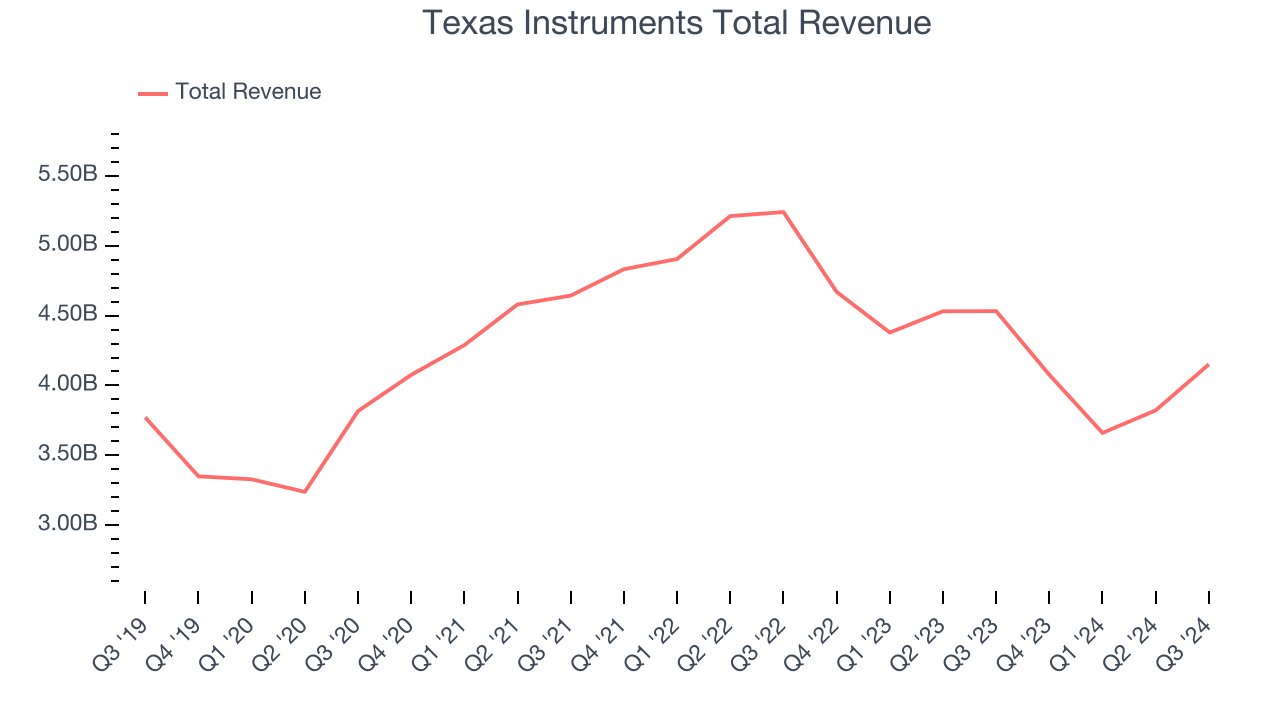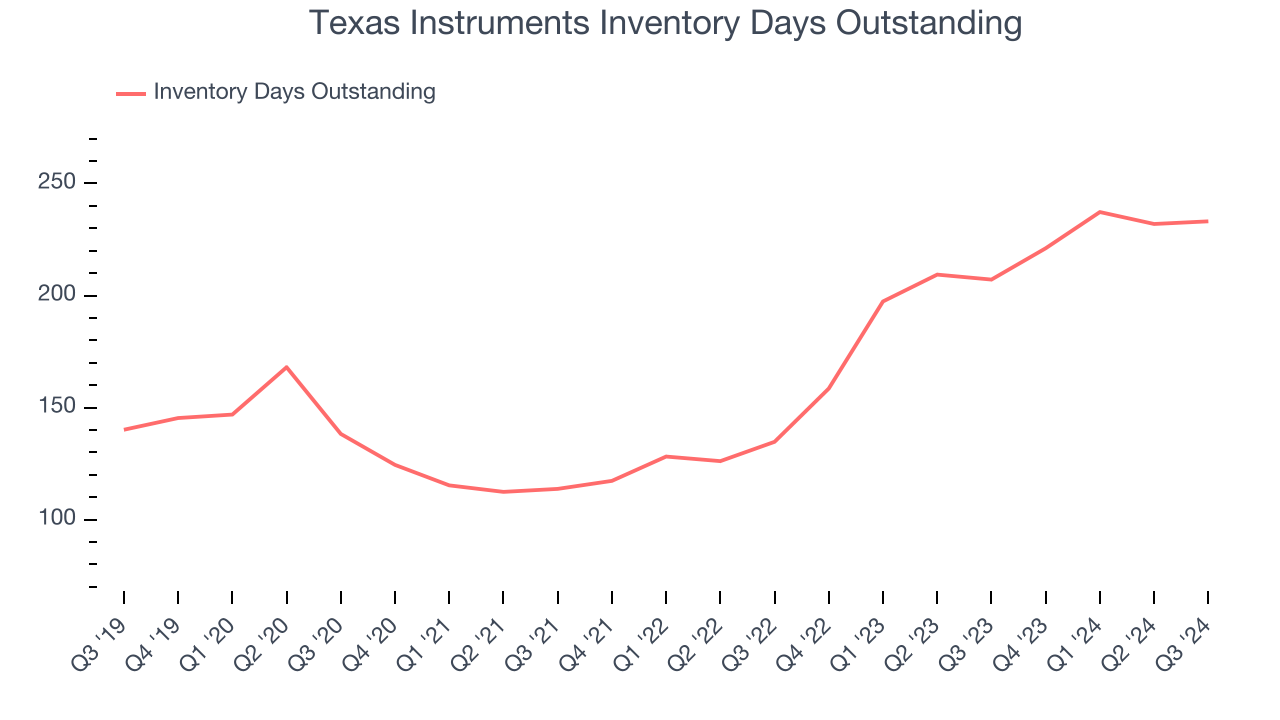
Analog chip manufacturer Texas Instruments (NASDAQ: TXN) met Wall Street’s revenue expectations in Q3 CY2024, but sales fell 8.4% year on year to $4.15 billion. On the other hand, next quarter’s revenue guidance of $3.85 billion was less impressive, coming in 5.6% below analysts’ estimates. Its GAAP profit of $1.47 per share was 7.1% above analysts’ consensus estimates.
Is now the time to buy Texas Instruments? Find out by accessing our full research report, it’s free.
Texas Instruments (TXN) Q3 CY2024 Highlights:
- Revenue: $4.15 billion vs analyst estimates of $4.12 billion (in line)
- EPS: $1.47 vs analyst estimates of $1.37 (7.1% beat)
- EBITDA: $2.02 billion vs analyst estimates of $1.89 billion (6.8% beat)
- Revenue Guidance for Q4 CY2024 is $3.85 billion at the midpoint, below analyst estimates of $4.08 billion
- EPS (GAAP) guidance for the full year is $1.18 at the midpoint, missing analyst estimates by 77.1%
- Gross Margin (GAAP): 59.6%, down from 62.1% in the same quarter last year
- Inventory Days Outstanding: 233, up from 232 in the previous quarter
- EBITDA Margin: 48.8%, in line with the same quarter last year
- Free Cash Flow Margin: 10%, similar to the same quarter last year
- Market Capitalization: $178.7 billion
Company Overview
Headquartered in Dallas, Texas since the 1950s, Texas Instruments (NASDAQ: TXN) is the world’s largest producer of analog semiconductors.
Analog Semiconductors
Demand for analog chips is generally linked to the overall level of economic growth, as analog chips serve as the building blocks of most electronic goods and equipment. Unlike digital chip designers, analog chip makers tend to produce the majority of their own chips, as analog chip production does not require expensive leading edge nodes. Less dependent on major secular growth drivers, analog product cycles are much longer, often 5-7 years.
Sales Growth
A company’s long-term performance can indicate its business quality. Any business can put up a good quarter or two, but many enduring ones grow for years. Over the last five years, Texas Instruments grew its sales at a weak 1.3% compounded annual growth rate. This shows it failed to expand in any major way and is a rough starting point for our analysis.
Semiconductors are a cyclical industry, and long-term investors should be prepared for periods of high growth followed by periods of revenue contractions.
Long-term growth is the most important, but recency is neccessary for semiconductors because of Moore's Law, which suggests the pace of technological innovation is so high that yesterday's hit new product could be obsolete today. Texas Instruments’s history shows it grew in the past but relinquished its gains over the last two years, as its revenue fell by 11.8% annually.
This quarter, Texas Instruments reported a rather uninspiring 8.4% year-on-year revenue decline to $4.15 billion of revenue, in line with Wall Street’s estimates. Management is currently guiding for a 5.6% year-on-year decline next quarter.
Looking further ahead, sell-side analysts expect revenue to grow 9.8% over the next 12 months, an acceleration versus the last two years. This projection is above the sector average and illustrates the market thinks its newer products and services will spur faster growth.
Today’s young investors won’t have read the timeless lessons in Gorilla Game: Picking Winners In High Technology because it was written more than 20 years ago when Microsoft and Apple were first establishing their supremacy. But if we apply the same principles, then enterprise software stocks leveraging their own generative AI capabilities may well be the Gorillas of the future. So, in that spirit, we are excited to present our Special Free Report on a profitable, fast-growing enterprise software stock that is already riding the automation wave and looking to catch the generative AI next.
Product Demand & Outstanding Inventory
Days Inventory Outstanding (DIO) is an important metric for chipmakers, as it reflects a business’ capital intensity and the cyclical nature of semiconductor supply and demand. In a tight supply environment, inventories tend to be stable, allowing chipmakers to exert pricing power. Steadily increasing DIO can be a warning sign that demand is weak, and if inventories continue to rise, the company may have to downsize production.

This quarter, Texas Instruments’s DIO came in at 233, which is 70 days above its five-year average, suggesting that the company’s inventory has grown to higher levels than we’ve seen in the past.
Key Takeaways from Texas Instruments’s Q3 Results
We were impressed by how significantly Texas Instruments blew past analysts’ EPS and EBITDA expectations this quarter. On the other hand, its full-year EPS forecast missed Wall Street’s estimates along with its revenue guidance for next quarter. Overall, this was a softer quarter. The stock remained flat at $193 immediately following the results.
So should you invest in Texas Instruments right now?The latest quarter does matter, but not nearly as much as longer-term fundamentals and valuation, when deciding if the stock is a buy.We cover that in our actionable full research report which you can read here, it’s free.






